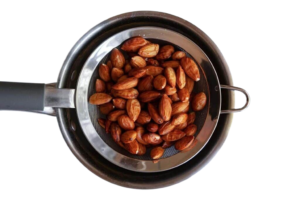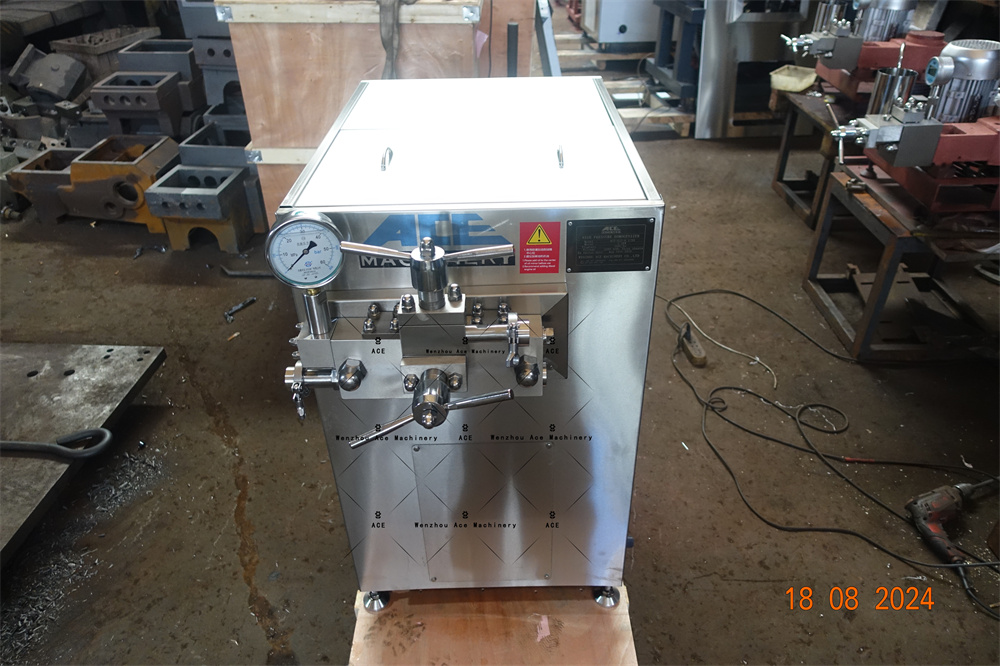How to Make Almond Milk at Home: Easy Steps
Almond milk is a delicious and healthy alternative to dairy milk. This plant-based drink is rich in vitamin E, which helps protect cells and boost the immune system. Making almond milk at home means no artificial additives or preservatives. Homemade almond milk tastes fresher, and you can add your own sweeteners and flavors. The process is simple and enjoyable – try it out for a healthier, tastier option!
Reference Video
Ingredients and Tools You’ll Need
List of Ingredients
Almonds
The main ingredient in almond milk is almonds. Choose raw, unsalted almonds for best results. Soak them in water for at least 8 hours or overnight to soften them up before blending.

Water
Water is necessary to make almond milk. Use fresh, clean water for this recipe. The general rule of thumb is one part almonds to three parts water – this will give you a nice creamy texture.
Optional Sweeteners and Flavors
Sweeteners and flavors can enhance the taste of almond milk. Common sweeteners include honey, sugar, agave syrup, or maple syrup. Vanilla extract or powder adds a nice flavor as well – feel free to experiment with different combinations until you find your favorite mix!
Tools You’ll Need
Blender
A blender is essential for making almond milk at home. A high-speed blender works best for this recipe – simply blend soaked almonds with water until smooth (this extracts the “milk” from the nuts).
Nut Milk Bag or Cheesecloth
A nut milk bag or cheesecloth is used to strain the blended almond mixture, removing any bits of almond pulp and leaving behind smooth liquid (milk). Place the bag/cloth over a bowl, pour in the blended mix, then squeeze out as much liquid as possible.
Bowl & Storage Container
You’ll need a large bowl to catch the strained almond milk during this process (to avoid spills). Once strained, transfer the milk into a storage container – glass jars or bottles with tight lids work well for this purpose. Keep it refrigerated.
Step-by-Step Guide to Making Almond Milk
Preparing the Almonds
Soaking the Almonds
Soak raw, unsalted almonds in water for at least 8 hours or overnight. This will help soften them up and make blending easier. Use a bowl and cover the almonds with plenty of water – they will absorb some of it and expand in size.

Rinsing and Draining
After soaking, drain the water from the almonds, then rinse them under fresh running water to remove any residue. Place the rinsed almonds in a colander or strainer to let excess water drain off – this step ensures cleaner taste for your homemade almond milk.

Blending Process
Adding Ingredients to Blender
Transfer soaked almonds into a high-speed blender. Add fresh water using a ratio of one part almonds to three parts water (for creamy texture). Optionally, sweeten with honey or maple syrup; also, vanilla extract can be used as a flavor enhancer.
Blending Until Smooth
Blend on high speed for about 2 minutes until the mixture turns white and creamy. The goal is to completely break down all almond pieces so that there are no large chunks left behind – stop the blender occasionally to check if necessary, then blend again if needed.
Straining the Mixture
Using a Nut Milk Bag or Cheesecloth
Place a nut milk bag or cheesecloth over a large bowl. Pour the blended mixture into the bag or cloth. Gather the edges and squeeze the liquid out. Press firmly to extract as much almond milk as possible. The remaining almond pulp can be used in other recipes.
Collecting the Almond Milk
Collect the strained almond milk in the bowl. Transfer the milk to an airtight container. Use a glass jar or bottle with a tight-fitting lid. Store the almond milk in the refrigerator. Fresh almond milk typically lasts 3–4 days.
Keeping Almond Milk Fresh
Choosing the Best Container
Use a container that keeps the almond milk fresh. Glass jars or bottles with tight-fitting lids are best. Plastic containers can pick up odors and flavors. Glass keeps the milk tasting fresh. Ensure the container is clean and dry.
Refrigeration Tips
Place the almond milk in the refrigerator right after making it. Keep it at 40°F (4°C) or colder. This prevents bacterial growth and keeps it fresh. Shake the container before each use. The milk separates naturally without additives. Fresh almond milk lasts about 3-4 days. Look for signs of spoilage like a sour smell or taste.
Tips and Notes for Best Results
Enhancing Flavor
Adding Sweeteners
Sweeteners can make almond milk taste better. Common options include honey, sugar, agave syrup, and maple syrup. Add sweeteners during the blending process. Start with a small amount. Taste the milk and add more if needed. Sweeteners dissolve best in warm milk. Warm the milk slightly if adding sweeteners after blending.
Using Flavors
Flavors can enhance the taste of almond milk. Vanilla extract or powder works well. Add a teaspoon of vanilla extract to the blender. For a chocolate twist, use cocoa powder. A pinch of cinnamon adds warmth. Experiment with different flavors to find your favorite combination.
Adjusting Consistency
Thicker Milk vs. Thinner Milk
The consistency of almond milk can vary. Some people prefer thicker milk. Others like it thinner. The almond-to-water ratio affects thickness. More almonds create thicker milk. Fewer almonds result in thinner milk.
How to Adjust
Adjust the consistency by changing the almond-to-water ratio. For thicker milk, use one part almonds to two parts water. For thinner milk, use one part almonds to four parts water. Blend and strain as usual. If the milk is too thick, add more water and blend again. If it’s too thin, add more soaked almonds and blend again.
Using Almond Milk in Various Recipes
Smoothies and Shakes
Start with a basic smoothie recipe using almond milk. Gather ingredients like frozen berries, a banana, and almond milk. Place all ingredients in a blender. Blend until smooth. Pour the smoothie into a glass. Enjoy a refreshing drink.
Protein Shake Recipe
Create a protein shake with almond milk. Use a scoop of protein powder, a banana, and almond milk. Add some ice cubes for a cold effect. Blend everything together until smooth. Drink the shake after a workout to boost protein intake.
Baking and Cooking
Pancakes with Almond Milk
Make pancakes using almond milk. In a bowl, mix flour, baking powder, and a pinch of salt. In another bowl, combine almond milk, an egg, and melted butter. Pour the wet ingredients into the dry ingredients. Stir until smooth. Cook the batter on a hot griddle. Flip the pancakes when bubbles form on the surface. Serve with syrup or fresh fruit.
Creamy Soups
Use almond milk for creamy soups. Start by sautéing onions and garlic in a pot. Add vegetables like carrots, potatoes, or broccoli. Pour in vegetable broth and bring to a boil. Reduce heat and simmer until vegetables are tender. Blend soup until smooth. Stir in almond milk for creaminess. Season with salt and pepper. Serve hot with crusty bread.
Storage Tips and Shelf Life
Proper Storage Methods
Refrigeration
Put almond milk in the fridge right after making it. Use a glass jar or bottle with a tight lid. Keep the fridge at 40°F (4°C) or colder. This stops bacteria from growing. Shake the container before each use. Almond milk separates naturally without additives.
Freezing
Freeze almond milk to make it last longer. Pour it into ice cube trays or freezer containers. Leave some space at the top because it expands when frozen. Label with the date. Thaw in the fridge before using again. Blend thawed milk to make it smooth.
Shelf Life Expectations
Freshness Duration
Homemade almond milk stays fresh for about 3–4 days in the fridge. It has no preservatives, so it spoils faster than store-bought kinds. Use it within this time for the best taste and quality.
Signs of Spoilage
Look for spoilage signs before drinking almond milk. A sour smell means it’s bad. The milk may also taste strange or look curdled. Throw it away if you see these signs. Always use clean utensils to avoid germs.
Frequently Asked Questions
Common Concerns
Can I Use Other Nuts?
Yes, other nuts can be used to make milk. Cashews, hazelnuts, and walnuts are popular choices. Each nut gives a different taste and texture. Soak the nuts like almonds. Follow the same blending and straining steps. Try different nuts to find your favorite.
How Long Does It Last?
Homemade almond milk lasts 3–4 days in the fridge. Store-bought almond milk lasts longer because of preservatives. Always check for spoilage signs before drinking. A sour taste or bad smell means it is spoiled. Mold or changes in texture also show spoilage.
Troubleshooting
Why Is My Milk Separating?
Separation happens naturally in homemade almond milk. This is due to no additives. The almond bits settle at the bottom. This does not mean it is spoiled. Shake the container before each use to mix it again.
How to Fix Common Issues
Common issues include grainy texture and bland taste. Blend longer to fix grainy texture. Use a high-speed blender for best results. Strain through a fine nut milk bag or cheesecloth. For bland taste, add sweeteners or flavorings like vanilla extract or salt. Adjust the almond-to-water ratio for the thickness you want.
It is simple and enjoyable to make almond milk at home. You will have pure milk without any additives. Experiment with various sweeteners and flavors until you find your favorite one. For additional health benefits, incorporate your own almond milk into smoothies, baking, or cooking. Leave a comment to share your opinion or ask questions. Have fun making almond milk!






